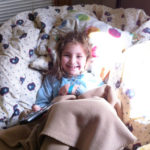 Between 2010 and 2013, between the ages of four and eight, my daughter Sammi had ten endoscopies. Each time, she fasted from dinner the night before until after her morning procedure. Each time, they held a gas mask over her face in the operating room until she fell asleep, and then, after escorting me out of the room, they inserted an IV with heavier anesthesia and fluids, took a blood sample, inserted a mouthpiece and fed a camera down into her esophagus. They took pictures and they took biopsies — tiny pieces of her esophagus to test for the presence of eosinophils, the white blood cells whose functions, according to Cincinnati Children’s Hospital, include
Between 2010 and 2013, between the ages of four and eight, my daughter Sammi had ten endoscopies. Each time, she fasted from dinner the night before until after her morning procedure. Each time, they held a gas mask over her face in the operating room until she fell asleep, and then, after escorting me out of the room, they inserted an IV with heavier anesthesia and fluids, took a blood sample, inserted a mouthpiece and fed a camera down into her esophagus. They took pictures and they took biopsies — tiny pieces of her esophagus to test for the presence of eosinophils, the white blood cells whose functions, according to Cincinnati Children’s Hospital, include
movement to inflamed areas, trapping substances, killing cells, antiparasitic and bactericidal activity, participating in immediate allergic reactions, and modulating inflammatory responses.
Ten times. They did that to her ten times in just over three years. They did that because she was still experiencing the symptoms of GERD — also known as “reflux” — past the age that a child would normally outgrow it. We took her to a major children’s hospital gastroenterology practice, a practice in the same hospital that had corrected her cardiac issue when she was a baby. Keeping everything in the same hospital made sense to us, at the time. All the records would be together, we thought. There would be less repeating ourselves, far fewer requirements of us to remember dates and test results — all the information would be stored with her chart.
We believed in the power of information sharing among professionals, which was a mistake.
In 2013, after those ten endoscopies had produced odd results that were not as consistent with the gastroenterologists’ certain diagnosis of eosinophilic esophagitis, an allergic disorder of the esophagus, one of the gastroenterologists with whom we had trusted with our daughter admitted that he had never read her medical chart.
He didn’t know about the way her esophagus had been crushed by a vascular ring for the first year of her life or that, in the years before she became his patient, she’d been treated for esophageal dysmotility — uncoordinated movement of food and liquids through her esophagus — because he hadn’t read her chart.
The question of how this happened was one that I had to put out of my head immediately when we realized it one November night in 2013. Within days, we had an order to bring Sammi back to the hospital for a barium swallow study. It is a simple test — not done under anesthesia, requiring neither an IV or a blood draw. All Sammi had to do was swallow barium.
When we arrived at the hospital that November morning in 2013, by some odd miracle, the radiologist who would be administering the test was the same one who had administered it to Sammi in 2006. I remembered him and told him so.
“So, what’s been going on?,” he asked.
“Well, she was diagnosed with eosinophilic esophagitis a few years ago…”
“Oh yeah,” he answered, rolling his eyes, “Her and everyone else. That’s the new thing.”
My stomach dropped.
The first thing Sammi had to do was drink a thick, chalky substance through a straw while lying down on a table under an x-ray machine. A screen behind her clearly showed us the route taken by the barium she drank:
I knew immediately what I was looking at. The dark shape in the middle of the screen is her esophagus. A normal esophagus goes straight down to the stomach, no curves. Sammi’s esophagus made turns. Sammi’s esophagus made more than one turn.
Down, turn left, turn right, down, turn right: the path of all substances from Sammi’s mouth to Sammi’s stomach. I watched that screen in horror as Sammi chirped at me from under the x-ray machine, “Is it time to take another sip, Mommy?”
The radiologist looked at the screen and said, “Wait one minute. I want to try something. I’ll be right back – tell her to sit up.”
He returned a moment later with a small paper cup filled with something that looked like marshmallow fluff. “It’s sweet, honey,” he said to Sammi. “I want you to swallow just one spoonful of it, and we’re going to see how fast it goes down.”
Sammi touched a finger to it and then swallowed one plastic spoonful, dutifully laying down afterward in just the right spot. I watched the screen as a blob exactly the shape of a spoonful went down to that first right turn, and came back up. Down again. Up again. Down again. Up again.
The radiologist sat her up, waited two minutes, and laid her back down. We watched the fluff continue to travel up and down the top third of her esophagus for another minute before I said, “Enough. Enough radiation. Do you know what you need to know?”
The radiologist nodded and flipped off the machine. Sammi went to the bathroom to change her clothes, and he pulled me aside.
“You have to call the cardiothoracic surgeon,” he whispered at me, urgently.
I didn’t understand. Her esophagus was shaped badly — why did we need the cardiac anything? Dysmotility, I thought. Bad muscles. Right? I told the radiologist all that, thinking he didn’t remember.
“No,” he said, pointing at the spot on the screen where her esophagus turned the most sharply. “That’s her aorta.”
The world shrank, sucked in from every corner of the earth into the radiology room as I absorbed what he said. That’s her aorta. I snapped a picture of the screen with my phone, and Sammi came out from the bathroom in her clothes, ready to go back to school. Then, I shoved the phone in my pocket along with what I’d just learned, but I couldn’t help look at her torso as we walked out of the hospital, picturing the path of every morsel she swallowed, and holding everything at once: new knowledge; powerful emotions; my forcefully withheld tears; and my beautiful, tortured daughter’s soft, cool hand.







Oh my goodness. This is so scary to read. It is unbelievable to me that a doctor wouldn’t read her medical chart. Well, not unbelievable, but unacceptable. I actually have a scope scheduled for myself tomorrow morning, as I developed reflux after pregnancy, and they found Barrett’s Esophagus. This really makes me want to question my doctors, and I’m going to read more of your blog. Thank you.
Shann, thanks for reading. Barrett’s is a scary finding — must have found it via a previous endoscopy, so what is tomorrow’s scope for? It’s totally fair to ask your doctors specific questions like: Why are you doing this test? Why now? What are you expecting you might find? What would knowing that change for me? How will we act on any information you uncover? None of those questions are unreasonable, and all of them can be asked with respect for the physician’s expertise. They know their specialty, but you know yourself.
Wow, such a shocking story! My mother had a lot of bad experiences with specialists! TOO long to list here!
It’s such a shame that this is true. Sammi had several absolutely fantastic specialists, and her pediatrician is one of the people I trust most in the world. Unfortunately, mistakes in medicine have such scary consequences.
[…] eight-year-old daughter Sammi’s aorta was smashing her esophagus into an unnatural shape that trapped food inside it every time she ate. After receiving that news — and the news that we needed to get my […]
[…] things took a long time to go down her esophagus. We had seen evidence of that on a barium swallow study. However, Sammi had never known anything else, so we did not know how to tell if the surgery had […]
[…] problems in her chest stemming from a heart condition when she was a baby. A simple test called a swallow study revealed that her esophagus was compressed by her aorta, trapping food inside that irritated the […]
[…] my kitchen counter overflowing with pans and bowls of every variety imaginable. Another year, her swallowing abilities diminished by her smashed esophagus, she asked not to have a cake, so we made bouquets and arrangements of […]